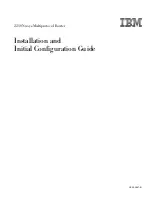
INTRODUCTION TO MULTIPLE-RING MMAC FUNCTIONALITY
A-5
A.4.2 Auxiliary Rings
Each port switching MIM has two auxiliary rings. These rings never
communicate with FNB rings, unless through an external device such as a
switch or router. A station on an auxiliary ring can only communicate
with stations attached to the same MIM and assigned to the same
auxiliary ring. Auxiliary rings are useful to provide a dedicated ring for
the transfer of large amounts of data, as occurs when “backing up”
servers.
A.4.3 Bypassed Rings
A management module can bypass (prevent communication among) any
port switching MIM from any or all of the FNB rings. Any station
connected to a bypassed ring will not communicate with FNB rings
(it can however communicate with other stations on that bypassed ring).
For example, stations attached to Ring 2 on a bypassed MIM will not
communicate with stations on MIMs inserted into FNB Ring 2.
A.5 A SAMPLE CONFIGURATION
The purpose of the port switching family of MIMs is to segment traffic
and provide the advantages described in
Section A.1
. As an example
configuration,
Figure A-4
shows an MMAC configured with multiple
rings. The users of each ring typically share a server. One of these user
groups is attached to a MAU that is connected to a TRXMIM port that has
been configured as a RO port. The switch provides the communication
among rings.
Содержание TRMM-4
Страница 1: ...TRMM 4 TOKEN RING MANAGEMENT MODULE USER S GUIDE BOOKTITLE2 OPTIONAL ...
Страница 2: ......
Страница 6: ...TRMM 4 QUICK REFERENCE QR 4 ...
Страница 14: ...CONTENTS viii ...
Страница 30: ...INTRODUCTION 1 12 ...
Страница 44: ...INSTALLATION 2 14 ...
Страница 52: ...MONITORING AND TROUBLESHOOTING 3 8 ...
Страница 70: ...SUPPORTED MIB GROUPS D 4 ...
Страница 74: ...INDEX IX 4 ...
















































